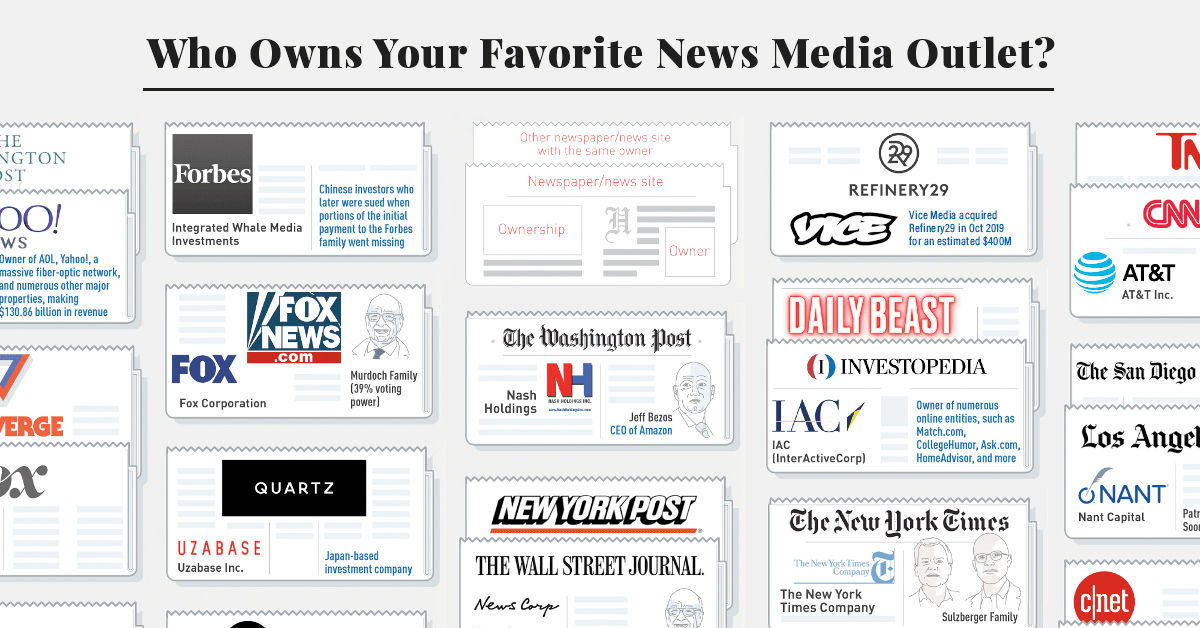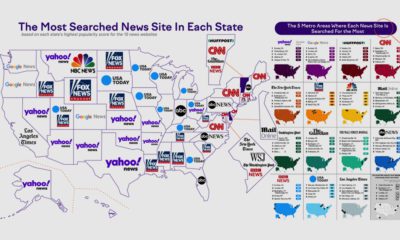Misc
Who Owns Your Favorite News Media Outlet?

Who Owns Your Favorite News Media Outlet?
It’s no secret that news media is a tough industry.
For various reasons — from tech disruption to changing media consumption habits — the U.S. has seen a net loss of 1,800 local newspapers over the past 15 years. As regional newspapers are bundled together, and venture-backed digital media brands expand their portfolios, the end result is a trend towards increased consolidation.
Today’s graphic, created by TitleMax, is a broad look at who owns U.S. news media outlets.
Escaping the News Desert
As outlets battle the duopoly of Google and Facebook for advertising revenue, the local news game has become increasingly difficult.
As a result, news deserts have been springing up all over America:
What happens when times get tough?
One option is to simply go out of business, while another traditional solution is to combine forces through consolidation. While not ideal, the latter option at least provides a potential route to revenue and cost synergies that make it easier to compete in a challenging environment.
Nation of Consolidation
Though the numbers have decreased in recent years, regional news media still reaches millions of people each day.
Below is a look at the top 20 owners of America’s newspapers:
| Parent Companies | Total Papers | Example brands |
|---|---|---|
| New Media Investment Group | 451 | Patriot Ledger, The Columbus Dispatch, The Providence Journal |
| Gannett | 216 | USA Today, Detroit Free Press, Arizona Republic |
| Digital First Media | 158 | Oakland Tribune, San Jose Mercury News, Denver Post |
| Adams Publishing Group | 144 | The Charlotte Sun, Wyoming Tribune-Eagle |
| CNHI | 114 | Niagara Gazette, The Huntsville Item, The Lebanon Reporter |
| Lee Enterprises | 100 | Arizona Daily Sun, St. Louis Post Dispatch |
| Ogden Newspapers | 81 | The Maui News, The Toledo Chronicle, Salem News |
| Tribune Publishing | 77 | Chicago Tribune, Los Angeles Times, The Baltimore Sun |
| Berkshire Hathaway Media | 75 | Buffalo News, Winston-Salem Journal, Omaha World-Herald |
| Shaw Media | 71 | Suburban Life Magazine, Putnam County Record |
| Boone Newspapers | 66 | The Austin Daily Herald, The Charlotte Gazette |
| Hearst Corp. | 66 | San Francisco Chronicle, Seattlepi.com, Houston Chronicle |
| Paxton Media Group | 58 | Daily Corinthian, Connersville News-Examiner |
| Landmark Media Enterprises | 55 | Citrus County Chronicle, The News-Enterprise |
| Community Media Group | 51 | Lafayette Leader, The Wellsboro Gazette |
| AIM Media | 50 | Odessa American, El Nuevo Heraldo |
| McClatchy | 49 | Idaho Statesman, Miami Herald, The Sacramento Bee |
| Advance Publications | 46 | The New Yorker, Vanity Fair, Wired, The Oregonian, NJ.com |
| Rust Communications | 44 | Cherokee Chronicle Times, Southeast Missourian |
| News Media Corp. | 43 | Cheyenne Minuteman, Brookings Register, Newport News Times |
Turnover in this segment of the market has been brisk. In fact, more than half of existing newspapers have changed ownership in the past 15 years, some multiple times. For example, the LA Times is now in the hands of its third owner since 2000, after being purchased by billionaire biotech investor Patrick Soon-Shiong.
The industry may be facing another dramatic drop off in ownership diversity as the two largest players, New Media Investment Group and Gannett, are on the path to merging. If shareholders give the thumbs-up during the vote this November, Gannett will have amassed the largest online audience of any American news provider.
The Flying Vs: Vox and Vice
It isn’t just regional papers being swept up in the latest round of mergers and acquisitions — new media is getting into the mix as well.
Vox Media recently inked a deal to acquire New York Media, the firm behind New York Magazine, Vulture, and The Cut.
I think you’re going to see that trend [of consolidation] across the industry. I just hope it’s done for the right reasons. You see too many of these things done for financial engineering.
– Jim Bankoff, CEO of Vox Media
Meanwhile, Vice recently acquired Refinery29 for $400 million, giving it access to a new audience skewed towards millennial women. This match-up seems awkward on the surface, but it allows advertisers to reach a broader cross-section of people within each ad ecosystem.
Both companies announced layoffs in the past year, and this restructuring may help both companies win as they consolidate resources.
The Bottom Line
While news media isn’t quite as consolidated as the broader media ecosystem, it’s certainly trending in that direction. Thousands of American communities that had local newspapers in 2004 now have no news coverage at all, while remaining papers are increasingly becoming units within an umbrella company, with no direct stake in community reporting.
That said, until the issue of monetization is definitively sorted out, consolidation may be the only way to keep the presses from stopping.
About the Graphic
This list of top 100 news sites was compiled using the following criteria:
– The top “digital-native” news outlets by monthly unique visitors (Pew Research and ComScore, excluding sports)
– The top newspapers by average Sunday circulation (Pew Research and Alliance for Audited Media)
– Alexa’s top sites under the category of news (U.S. only, excluding user-generated)
Note: The graphic has been updated to reflect changes in ownership for Refinery29, Gizmodo, and Jezebel.
Misc
How Hard Is It to Get Into an Ivy League School?
We detail the admission rates and average annual cost for Ivy League schools, as well as the median SAT scores required to be accepted.

How Hard Is It to Get Into an Ivy League School?
This was originally posted on our Voronoi app. Download the app for free on iOS or Android and discover incredible data-driven charts from a variety of trusted sources.
Ivy League institutions are renowned worldwide for their academic excellence and long-standing traditions. But how hard is it to get into one of the top universities in the U.S.?
In this graphic, we detail the admission rates and average annual cost for Ivy League schools, as well as the median SAT scores required to be accepted. The data comes from the National Center for Education Statistics and was compiled by 24/7 Wall St.
Note that “average annual cost” represents the net price a student pays after subtracting the average value of grants and/or scholarships received.
Harvard is the Most Selective
The SAT is a standardized test commonly used for college admissions in the United States. It’s taken by high school juniors and seniors to assess their readiness for college-level academic work.
When comparing SAT scores, Harvard and Dartmouth are among the most challenging universities to gain admission to. The median SAT scores for their students are 760 for reading and writing and 790 for math. Still, Harvard has half the admission rate (3.2%) compared to Dartmouth (6.4%).
| School | Admission rate (%) | SAT Score: Reading & Writing | SAT Score: Math | Avg Annual Cost* |
|---|---|---|---|---|
| Harvard University | 3.2 | 760 | 790 | $13,259 |
| Columbia University | 3.9 | 750 | 780 | $12,836 |
| Yale University | 4.6 | 760 | 780 | $16,341 |
| Brown University | 5.1 | 760 | 780 | $26,308 |
| Princeton University | 5.7 | 760 | 780 | $11,080 |
| Dartmouth College | 6.4 | 760 | 790 | $33,023 |
| University of Pennsylvania | 6.5 | 750 | 790 | $14,851 |
| Cornell University | 7.5 | 750 | 780 | $29,011 |
*Costs after receiving federal financial aid.
Additionally, Dartmouth has the highest average annual cost at $33,000. Princeton has the lowest at $11,100.
While student debt has surged in the United States in recent years, hitting $1.73 trillion in 2023, the worth of obtaining a degree from any of the schools listed surpasses mere academics. This is evidenced by the substantial incomes earned by former students.
Harvard grads, for example, have the highest average starting salary in the country, at $91,700.
-

 Real Estate2 weeks ago
Real Estate2 weeks agoVisualizing America’s Shortage of Affordable Homes
-

 Technology1 week ago
Technology1 week agoRanked: Semiconductor Companies by Industry Revenue Share
-

 Money1 week ago
Money1 week agoWhich States Have the Highest Minimum Wage in America?
-

 Real Estate1 week ago
Real Estate1 week agoRanked: The Most Valuable Housing Markets in America
-

 Business1 week ago
Business1 week agoCharted: Big Four Market Share by S&P 500 Audits
-

 AI2 weeks ago
AI2 weeks agoThe Stock Performance of U.S. Chipmakers So Far in 2024
-

 Misc2 weeks ago
Misc2 weeks agoAlmost Every EV Stock is Down After Q1 2024
-

 Money2 weeks ago
Money2 weeks agoWhere Does One U.S. Tax Dollar Go?





